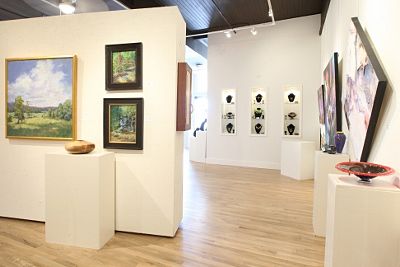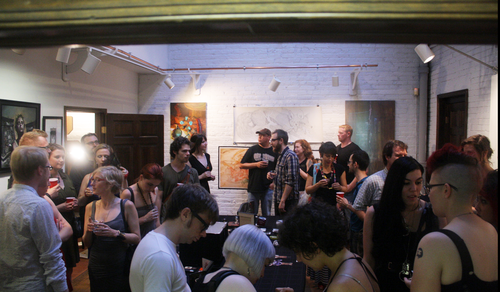New York City artist and agent Samantha Levin shares her expertise on how artists can make connections with the right galleries for their work.

It can be very demoralizing when you get no response from multiple galleries to which you have submitted your work. Even those that ask for submissions on their website tend not to reply. You are left with no feedback, and thus no way to fix whatever you might be doing wrong.
Simply, you may only need to alter your approach. I often find myself telling my advisement clients that the best way to get attention from a gallery is through connections, not through blind submissions. A peer group developed from getting to know your colleagues well can be your most valuable career asset.
To quote my good friend, award winning illustrator and artist’s advisor Zelda Devon, “[To succeed, you need to] Surround yourself with peers who have similar goals and motivations.” It’s pretty much the same in any industry, really. Your close peers can recommend you, offer clear feedback, give you stamps of credibility and trustworthiness, and provide direct connections to galleries.
As an artist, you need to be sensitive to the fact that galleries get tons of submissions. For them to review and respond to all of them would be irresponsible, because it would take precious time away from keeping their business functional. All their energy must be spent supporting artists with whom they have established business relationships, and fostering connections with collectors who buy art.
To put it straight: they need to focus on the things that make money. Galleries are not like museums, there for the public’s pleasure – they are businesses that, like any other, will close if they don’t make sales. It may seem like an obvious statement to make, but many people egregiously misunderstand this.

Galleries often find new talent via their trusted business connections. Their established business peers already know exactly what they look for. From the book Collecting Contemporary Art (25) by Adam Lindemann (a book I highly recommend), gallerists Bruno Brunnet and Nicole Hackert state, “Most often, it is other artists who recommend new artists to us. When we choose an artist, there’s a lot of chemistry involved. Not only do we look at the work, but it’s the person sending out signals. For instance, we offered Jonathan Meese a show after meeting him for 15 minutes, and before we had seen a single piece of art, only because we both felt that somebody very special with an incredibly rare talent had crossed our way. Also you’ve got to get along with an artist on a personal level. This doesn’t mean that he or she must be polite, well-behaved and share all your views. It is, as mentioned, a more “chemical” thing and it definitely has to do with sharing the same sense of humor and fears.”
This is not how every gallery works, but certainly points out that strong professional and personal relationships can support an artist’s career exponentially. It’s also an indication of how arbitrary a gallery’s choice of artists can seem. They took 15 minutes to offer this artist a show without having seen his art!
Submitting your artwork to galleries is likely what you were told to do by your art teachers. It’s true that sometimes sending your work out can garner attention. However, in order to up your chances for getting a response, you need to know how each individual gallery works as well as an in-depth understanding of what they look for before you submit your work to them.
Each gallery works differently, not to mention that they all work in various subsets of the art industry. Thorough research is necessary to find galleries that your work fits into, as well as ensure that they are trustworthy and sound.
Spending some time perusing a gallery’s website will not provide you with enough information. You need to do much more. That’s an unbelievable amount of research! How do you sift through the thousands of galleries out there to find those suitable for you and your work?
The best way to whittle down the mass of galleries you could start looking into is via your peer group. Through your colleagues, you can find trustable information about the reputation of any gallery. Just as Brunnet and Hackert find artists, you can find galleries that will best suit your needs (maybe taking more than 15 minutes to make a business deal with them, though).
Such connections will also help you weed out galleries that will hurt you. Some places are renowned for losing artwork in the mail, mishandling artwork, failing to publicize important shows, keeping money owed to artists, lying about sales information or relying on an artist’s collectors for sales while still keeping 50%. Everyone makes mistakes sometimes, but if a gallery is known for repeating the same offenses over and over, then steer clear!
A peer group can also help you find other ways of selling your artwork. I’ve heard many artists complain about how pointless certain shows were for them – shipping and framing costs often trump the sales commissions they get, if their work sells at all. Consequently, some of them only agree to an exhibition if they know it will provide them with something very valuable in return, such as strong connections, marketing, sure-fire attention from dealers, etc. The benefits must outweigh the costs. Resume padding only goes so far.
Make sure you’re not limiting your career by gallery chasing or romanticizing the experience of having your work in an exhibition. There are other paths you can take that should not be discredited (no, you will not be selling out).
The aforementioned artists make money from their art in all sorts of ways including commissions, tattoo designs, illustration, limited edition prints, graphic design, comics, story board illustration, etc. They utilize Society6, BigCartel, Etsy, Twitter, Instagram, Tumblr, Facebook and other social networking platforms to market their work, network with other similar artists (establish a peer group online) and publicly establish their personality (develop their brand).
There’s also licensing, wholesaling, festivals and fairs and a myriad of other tools and options an artist can use to establish their career (Artsy Shark has tons of advice on all of these). It’s not easy to do any of this, but many artists figure it out by using their intuition and watching what works best so they can duplicate good results. Often their gut tells them to move their careers away from the gallery model. I’ve seen many artists sales grow exponentially once they put aside their efforts towards exhibiting their work in the infamous white box.
In conclusion, a peer group is your greatest asset, far and beyond obtaining gallery representation. If you’re shy, in an isolated area or limited in any way, you need to find ways to connect with other artists either on the web, or even at your local library. Create forums, schedule events…do whatever it is you have to do to connect with other like minds.


Good Article… very informative for artists and described well
Thanks Suneel!
Thank you Samantha for this advice, yes this has happened a lot with me in my early years , and I had no answers why there were no replies from art galleries! it helps to know their side as well. Thank you, Take Care and All the Best!
You’re very welcome! Of course, even when you know their side, it’s still difficult to get an art show. I’ve seen some artists persist for years before getting a gallery’s attention. The best way forward is to keep trying and growing.
Inspiring article I wish I has read it back in the 60’s. ” Help for Hermits” I and others are not social animals. The white box . I like that. Good booze, delicious snacks a trillion dollars in framing and everyone is checking out each others dress or whom is with whom. You could have dirty bed sheets hanging on the walls. I think I was at that show.
Good article, somewhat encouraging, depending on how you look at it.
I guess these days any artist who wants to make the living from his or her art better start to socialize, especially online. One fact will never change “it’s who you know what matters”.
Thank you for the art work.
I need a gallery outside of mexico. I have reached some things in my country but that is not the way to achieve success.
Need to cantact you, just to show my work.
Not expensive. My square meter is 4,300 usd. Everything sold out.
Thank you for your time.
Gracias.
Thanks for everything you wrote.
I’m Ofer MizraChi
Looking for New Gallery Representation.
Ofer MizraChi
[email protected]
http://www.Ofermizrachi.com